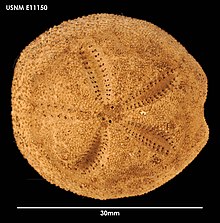| Abatus agassizii | |
|---|---|

| |
| Scientific classification | |
| Domain: | Eukaryota |
| Kingdom: | Animalia |
| Phylum: | Echinodermata |
| Class: | Echinoidea |
| Order: | Spatangoida |
| Family: | Schizasteridae |
| Genus: | Abatus |
| Species: | A. agassizii |
| Binomial name | |
| Abatus agassizii (Pfeffer, 1889) | |
Abatus agassizii is a species of sea urchin of the family Schizasteridae. Their armour is covered with spines. It is in the genus Abatus and lives in the sea. Abatus agassizii was first scientifically described in 1889 by Georg Pfeffer.
The Abatus agassizii is an irregular sea urchin species. Its habitat mostly includes South Georgia and the South Shetland Islands. Because of its habitat in the Antarctic region, the species shows strong adaptability to the shrinking and expansion of the Antarctic continental ice sheet. Moreover, the species stays located in shallow parts of less disturbed areas of the Antarctic marine environments, since the Antarctic benthos is considered one of the most disturbed in the world.
Digestive System
The Abatus agassizii has a twice-looped digestive system that's three times as long as the given species individual itself. The species is a deposit-feeder, which means it relies on the consumption of the sediment it stays burrowed in. It is also characterized by incredibly slow digestion. The system is made up of several regions: the buccal cavity, anterior esophagus, posterior esophagus, anterior stomach, posterior stomach, intestine, and rectum. Because of the low-complexity of the agassizii's diet, it is proposed that this long digestive tract holds a diverse gut microbiota.
References
- Kroh, A. (2010). Abatus agassizii (Pfeffer, 1889). In: Kroh, A. & Mooi, R. (2010) World Echinoidea Database. at the World Register of Marine Species
- Díaz, Angie; González-Wevar, Claudio Alejandro; Maturana, Claudia S.; Palma, Alvaro T.; Poulin, Elie; Gerard, Karin (December 2012). "Restricted geographic distribution and low genetic diversity of the brooding sea urchin Abatus agassizii (Spatangoidea: Schizasteridae) in the South Shetland Islands: A bridgehead population before the spread to the northern Antarctic Peninsula?". Revista chilena de historia natural. 85 (4): 457–468. doi:10.4067/S0716-078X2012000400008. ISSN 0716-078X.
- Palma, Alvaro T.; Poulin, Elie; Silva, Marcelo G.; San Martín, Roberto B.; Muñoz, Carlos A.; Díaz, Angie D. (2007-02-01). "Antarctic shallow subtidal echinoderms: is the ecological success of broadcasters related to ice disturbance?". Polar Biology. 30 (3): 343–350. doi:10.1007/s00300-006-0190-x. ISSN 1432-2056. S2CID 34394775.
- ^ Schwob, Guillaume; Cabrol, Léa; Poulin, Elie; Orlando, Julieta (2020). "Characterization of the Gut Microbiota of the Antarctic Heart Urchin (Spatangoida) Abatus agassizii". Frontiers in Microbiology. 11: 308. doi:10.3389/fmicb.2020.00308. ISSN 1664-302X. PMC 7058685. PMID 32184772.
| Taxon identifiers | |
|---|---|
| Abatus agassizii | |
 | This article about a sea urchin is a stub. You can help Misplaced Pages by expanding it. |